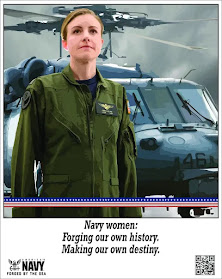 |
| Four of the first six women aviators (NHHC) |
In celebrating the achievements of women in the Navy over the past fifty years we remember the struggles involved in reaching equality and justice. Career opportunities for women were not the same as for men just a generation ago.
One of the things that bugged the first women naval aviators, for example, was inequality of training opportunities. While their male contemporaries learned sea service skills such as navigation and operations, women were often restricted to classroom lectures on administration.
Women officer candidates in the unrestricted line had to wear skirts and heels, even when marching in the snow. Women’s restrooms were few and far between. Pregnancy was punished.
As for training, a retired captain remembers how, while her male shipmates were learning how to operate patrol boats, she and her female classmates had to listen to “a representative from Max Factor instruct us on the proper wearing of makeup.”
In the early 1970s women were not permitted to serve aboard ships. Women were also not allowed to serve as Navy pilots.
But thanks to brave women and men –– military and civilian –– equality was achieved beginning in the 70s and over the following decades.
Beverly Weintraub, a winner of the Pulitzer Prize, tells the story of the fight for equality in “Wings of Gold: The Story of the First Women Naval Aviators” (Lyons Press, 2021). The book centers on the challenges, ordeals, and achievements of naval aviation’s first women pilots: Barbara Ann Allen Rainey, Judith Ann Neuffer Bruner, Jane Skiles O’Dea, Joellen Drag Oslund, Rosemary Bryant Merims Conatser Mariner, and Ana Maria Scott. (All but one of the women were military brats –– daughters of service members or veterans).
The first women in naval aviation faced a calcified male-centric culture within the Navy that was often either patriarchal or predatory, or both.
But the predicate for women serving in the military, even as aviators, had been made half a generation earlier.
 |
| The first class of WAVES to graduate from Aviation Metalsmith School in Norman, Oklahoma, July 30, 1943. (NHHC) |
“Fortunately for the female aviators determined to make the navy their career, there were officers up the chain of command willing to become not only mentors, but friends,” Weintraub writes.
 |
| Adm. Elmo "Bud" Zumwalt |
Zumwalt released his Z-gram #116 in August 1972: “Equal Rights and Opportunities for Women in the Navy.” His Z-gram #116 eventually became the blueprint for ensuring women could serve in aviation, aboard ship, and eventually in combat and aboard submarines. Zumwalt was supported by Secretary of the Navy John Warner and later by Senators William Cohen, John McCain, William Roth, and Ted Kennedy, as well as Representatives Beverly Byron and the Patricia Schroeder (a champion of women in the military who passed away last week).
Another key reformer and champion for women’s rights was the remarkable Adm. William P. Lawrence, considered by some a “radical feminist.” USS William P. Lawrence (DDG-110) is home-ported in Pearl Harbor, Hawaii. The ship’s commanding officer is Cmdr. Kellie Smith.
 |
| USS William P. Lawrence (DDG-110) participates in RIMPAC 2022 last summer. (MC3 Aleksandr Freutel) |
 |
| Former SECNAV Jim Webb |
Weintraub shows how Webb’s position fortified discrimination and justified harassment of women in the minds of some men, even helping lead to the watershed event that became a profound catalyst for change within the Navy: the Tailhook Convention at the Las Vegas Hilton in 1991.
Courageous women –– feminists, activists, and military members seeking justice –– accelerated change. “It would take a series of lawsuits by military women to bring policies, if not attitudes, in synch with the times,” Weintraub writes.
"Wings" fills a void in the important history of the advancement of women in the Navy. One of the best features of this book is the inclusion of interviews and testimonials of the first women aviators as well as other women who pioneered progress. Weintraub does a great job of following the lives of the first women naval aviators, including into retirement.
“I will always miss the smell of jet fuel and salt air,” said Jane Skiles O’Dea.
Rosemary Mariner, who once wrote “Adm. Zumwalt changed my life,” said in an interview about women being allowed to serve on submarines, “We will have made progress when this is not a newsworthy event.”
The book opens and concludes with a historic flyover on February 2, 2019, in which the Navy executed the first all-women missing man formation flyover in navy history.
That flyover may remind readers that an all-women team from California performed a flyover at Super Bowl LVII last month to honor fifty years of women in the Navy.
 |
| The All-Women flyover team for Super Bowl LVII poses for a group photo at Luke Air Force Base, Feb. 10, 2023. (MC1 Bobby Bladock) |
| Happy Women’s History Month. |



No comments:
Post a Comment